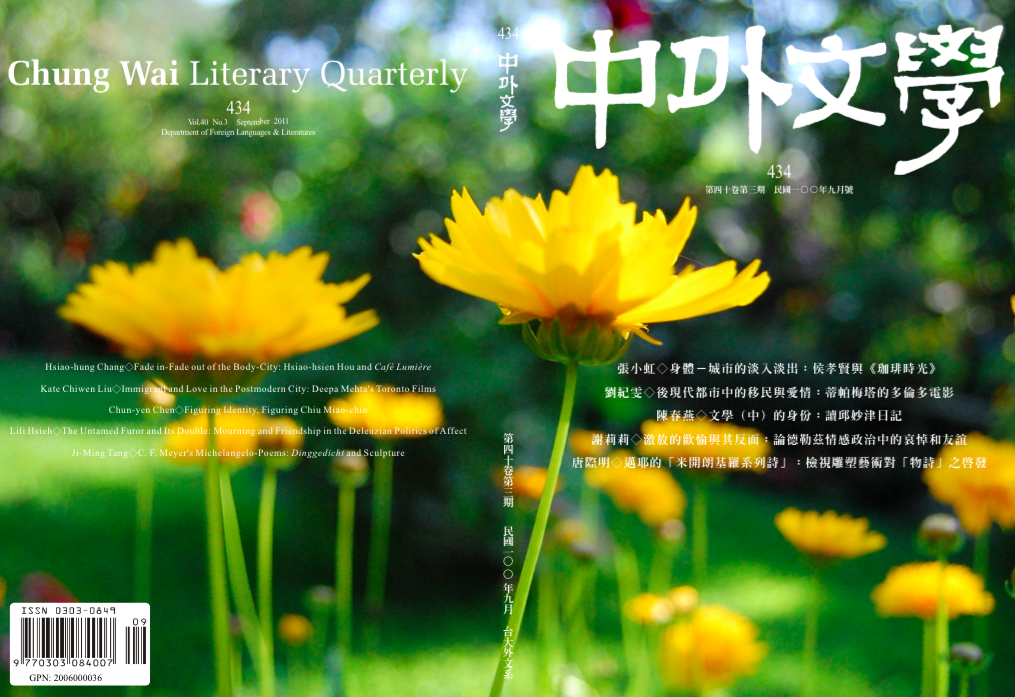第四十卷 第三期 總434 中華民國100年9月
Vol.40 No.3 September 2011

《中外文學》九月號收錄了五篇精彩論文:張小虹透過侯孝賢拍攝東京日常生活的電影《珈琲時光》,探討「淡入淡出」如何由電影美學形式,轉換為一種生命影像哲學;劉紀雯討論印裔加拿大導演蒂帕梅塔(Deepa Mehta)的四部多倫多電影,剖析影片所建構出的多倫多離散空間如何成為跨族裔、跨性別對話的社會空間;陳春燕挪用儂曦、阿岡本等理論家的觀念,解析邱妙津相關研究,思索文學研究對身份的討論,藉以釐清身份政治與獨一性理論之間的關係;謝莉莉重新檢視德勒茲哲學中幾個關鍵的衝突點,藉此讓思想與情感、以及在政治上看似對立的兩端,有了重新結盟的契機;唐際明則由瑞士德語詩人邁耶(C. F. Meyer)四首以米開朗基羅及其作品為主題所作的詩歌,以及兩首「物詩」的經典代表作切入,探索雕塑藝術對「物詩」之啟發。
中外文學九月號目錄
Contents
張小虹╱身體-城市的淡入淡出:侯孝賢與《珈琲時光》
身體-城市的淡入淡出
侯孝賢與《珈琲時光》
張小虹*
摘要
◎關鍵詞:侯孝賢,《珈琲時光》,身體,城市,淡入,淡出,電車,身動力
★國立臺灣大學外國語文學系教授。
Hsiao-hung Chang╱Fade in-Fade out of the Body-City: Hsiao-hsien Hou and Café Lumière
Fade in-Fade out of the Body-City
Hsiao-hsien Hou and Café Lumière
Hsiao-hung Chang*
Abstract
◎Keywords: Hsiao-hsien Hou, Café Lumière, body, city, fade in, fade out, train, affect
★ Professor, Department of Foreign Languages and Literatures, National Taiwan University.
劉紀雯╱後現代都市中的移民與愛情:蒂帕梅塔的多倫多電影
後現代都市中的移民與愛情
蒂帕梅塔的多倫多電影
劉紀雯*
摘要
◎關鍵詞:蒂帕梅塔,多倫多,雜多,離散,反異國情調化
★輔仁大學英國語文學系副教授。
Kate Chiwen Liu╱Immigrant and Love in the Postmodern City: Deepa Mehta’s Toronto Films
Immigrant and Love in the Postmodern City
Deepa Mehta’s Toronto Films
Kate Chiwen Liu*
Abstract
◎Keywords: Deepa Mehta, Toronto, Hybridity, Diaspora, Anti-Exotic Reading
★ Associate Professor, English Department, Fu Jen University.
陳春燕╱文學(中)的身份:讀邱妙津日記
文學(中)的身份
讀邱妙津日記
陳春燕*
摘要
◎關鍵詞:邱妙津,身份,獨一性,賦形,界限,併例,儂曦,阿岡本
★國立臺灣師範大學英語學系副教授。
Chun-yen Chen╱Figuring Identity, Figuring Chiu Miao-chin
Figuring Identity, Figuring Chiu Miao-chin
Chun-yen Chen*
Abstract
◎Keywords: Chiu Miao-chin (Qiu Miaojin), identity, singularity, figure, the limit, example, Jean-Luc Nancy, Giorgio Agamben
★Associate Professor, Department of English, National Taiwan Normal University.
謝莉莉╱激放的歡愉與其反面: 論德勒茲情感政治中的哀悼和友誼
激放的歡愉與其反面
論德勒茲情感政治中的哀悼和友誼
謝莉莉*
摘要
◎關鍵詞:德勒茲,情感,友誼政治,憂鬱,群體
★國立中央大學英美語文學系副教授。
Lili Hsieh╱The Untamed Furor and Its Double: Mourning and Friendship in the Deleuzian Politics of Affect
The Untamed Furor and Its Double
Mourning and Friendship in the Deleuzian Politics of Affect
Lili Hsieh*
Abstract
◎Keywords: Deleuze, affect, politics of friendship, melancholy, collectivity, group
★Associate Professor, English Department, National Central University.
唐際明╱邁耶的「米開朗基羅系列詩」:檢視雕塑藝術對「物詩」之啟發
邁耶的「米開朗基羅系列詩」
檢視雕塑藝術對「物詩」之啟發
唐際明*
摘要
◎關鍵詞:物詩,雕塑,米開朗基羅,形象化,手勢,動靜對立,意志,模仿
★國科會人文學研究中心博士後研究員。
Ji-Ming Tang╱C. F. Meyer’s Michelangelo-Poems: Dinggedicht and Sculpture
C. F. Meyer’s Michelangelo-Poems
Dinggedicht and Sculpture
Ji-Ming Tang*
Abstract
◎Keywords: Dinggedicht, sculpture, Michelangelo,objective, gesture, contrapposto, will, mimic
★ Postdoctoral Research Fellow, Center for Humanities Research, National Science Council.
